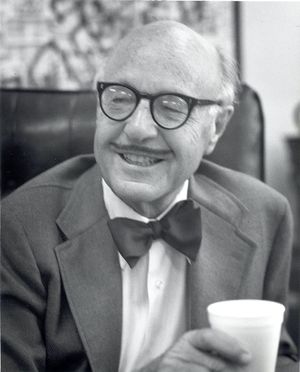Daniel Noble
- Birthdate
- 1901/10/04
- Birthplace
- Naugatuck, CT, USA
- Death date
- 1980/02/16
- Associated organizations
- Motorola
- Fields of study
- Radio
- Awards
- IEEE Edison Medal, WEMA Medal of Achievement, Stuart Ballantine Medal, University of Connecticut Engineering Alumni Plaque
Biography
Daniel E. Noble (IRE Associate, 1925; Senior Member; and Fellow, 1947), born on 4 October 1901, in Naugatuck, Connecticut, received his B.S. degree in engineering from Connecticut State College (now University of Connecticut) in 1929. He studied at Harvard University summer school and attended Massachusetts Institute of Technology as a graduate student.
Afterward he taught at Connecticut State College, where he rose to the rank of Assistant Professor. During these years he was the designer, builder, operator and manager of the College broadcast station. The success of his effort at the college led Hartford stations WTIC and WDRC to ask him to build relay stations for them. With WDRC, Noble eventually built one of the first commercial FM broadcast stations.
On the heels of this success, the Connecticut State Police came to him for engineering assistance. Dr. Noble originated the systems planning for the State Police radio system and personally supervised every phase of site selection, testing and design detail. Completed in 1940, this was the first two-way state police system to be placed in operation and the first practical two-way FM radio telephone mobile system in the world.
Career with Motorola
When the success of the Connecticut system became widely known, Noble's work came to the attention of Paul V. Galvin, owner of the Galvin Manufacturing Corporation (later changed to Motorola, Inc.) in Chicago. Although Noble was unsure of his permanent interest in industrial work, he joined Motorola as Director of Research in 1940.
His first work at Motorola included development of FM communications equipment for police and the U.S. Signal Corps. He was directly responsible for the systems concept and the direction of the development of the U.S. Army's SCR-300 FM Walkie-Talkie.
After the war, Noble began work in solid state electronics. In 1949 he set up a solid state electronics research laboratory for Motorola in Phoenix. This was the start of Motorola's semiconductor work and would eventually lead to the establishment of the Semiconductor Products Division (now the Semiconductor Group) for the company.
Noble was deeply interested in the application of transistors for FM mobile systems and wished to develop power transistors and radio frequency transistors. At his request, Dr. Bill Taylor succeeded in developing the power transistor. Dr. Noble immediately set out to develop it further with the conviction that this was a possible method to design transistors for operation in UHF bands and beyond.
Noble deserved much of the credit for Motorola becoming a power in mobile communications. During his career at the company he held a variety of positions, including Director of Research; General Manager of the Communications Division; Vice President and Director of Motorola, Inc.; Vice President and Director in charge of the Communications Division; Group Executive Vice President and Vice Chairman of the Board and Chief Technical Officer of the Corporation. He went into semi-retirement in 1970.
Service and Personal Life
He authored many papers in his career and held nine patents on electronics. Dr. Noble was also a talented and thoughtful artist. As a painter his works were reproduced on book and magazine covers.
Noble served on many technical committees including the Chairmanship of Panel 13 (Mobile and Portable Radio Telephone Communications) of the Radio Technical Planning Board and as a member of the National Television Color Systems Committee, which established the transmission standards for color TV. He also served on the Boards of both IRE and IEEE. He was a member of the National Academy of Engineering and a Life Fellow of the IEEE and the Franklin Institute. He received the WEMA Medal of Achievement, the Franklin Institute's Stuart Ballantine Medal and the University of Connecticut Engineering Alumni Plaque. He was the 1978 IEEE Edison Medal Recipient "For leadership and innovation in meeting important public needs, especially in developing mobile communications and solid-state electronics."
Daniel Noble and his wife, Mary, had three sons and a daughter. He died in Arizona on 16 February 1980, at the age of 78.
